
James Webb Space Telescope: The Background
Hi, I’m Marley, the astronomer here at the Space Centre.
In a little over a month, and barring any last-minute complications, the James Webb Space Telescope (JWST) will launch on December 18th. In this blog post I want to talk a little bit about the journey to get to launch day.
JWST History
The quest for a telescope beyond the capabilities of the Hubble Space Telescope began before Hubble was launched into orbit in 1990. As early as 1988 scientists were talking about the possibilities for a telescope that observed in the infrared part of the electromagnetic spectrum. Discussions about the size of the telescope, along with where exactly in the electromagnetic spectrum it should observe continued over the years. And then a government recession of 1991-92 and problems with Hubble’s mirror led to little work done on what was being called the Next Generation Space Telescope (NGST). In 1996 an 18-member committee made up of scientists, engineers, and led by astronomer Alan Dressler formally recommended that NASA should develop a space observatory for the infrared spectrum. By 2001 the size of the primary mirror was settled on—a huge 6.5 m diameter mirror, and in 2002, the name was changed to James Webb Space Telescope, in recognition of James Webb, the NASA administrator instrumental in ensuring science would be as important as human space flight in the future of NASA.
Construction on Webb did not start until 2004. In 2005 the Ariane 5 rocket was chosen as the launch vehicle, from the European Space Agency’s (ESA) Centre Spatial Guyanais (CSG) spaceport in French Guiana. In 2005, the planned launch for JWST was 2013, and the budget was 3 billion USD! Now, as of September 2021, the telescope still hasn’t launched, and its cost is about 10 billion USD. Why so expensive?
Anticipating the costs of missions is very difficult, especially with something as complicated as JWST. There are four separate science instruments, a guiding system, and of course – those gorgeous golden mirrors. Every aspect has to work together, especially since Webb will be unreachable once it is launched.
JWST Orbit
Credit: STScI

Webb will be located at what is called LaGrange point 2, or L2. A Lagrange point is a place in space where things tend to stay where they are. In the most common situation, there are two large objects: the Sun and Earth, and then a third smaller one, in this case, JWST. The gravitational force of the two large objects interacts and creates regions of enhanced attraction and enhanced repulsion. In a system with two bodies, there are 5 special points where the smaller object can move in a constant pattern with the two larger ones, and not move out of orbit. These 5 special points are the Lagrange points. JWST will sit at L2 for multiple reasons.
Since JWST will observe in the infrared, it will sense its own heat. This means that the telescope needs to stay cold. It has a large sunshield to block heat from the Sun and Earth, but this is only effective if the Sun and Earth are behind the telescope. With all these blocked, JWST will have an unimpeded view of the sky. Being at L2 is also perfect for communications. Essentially, JWST will be at the same position in relation to the Earth and the Sun at all times. This means that it will never be in a place where we can’t send it commands, or in a place where the telescope can’t see. This is different from Hubble, which every 90 minutes goes into Earth’s shadow – meaning we become limited to where we can look. While L2 certainly has its pros, it definitely has one major con: being more than 4 times the distance between the Earth and the Moon, if anything goes wrong with Webb, we will not be able to fix it.
Where are we at now?
On October 12th 2021, JWST arrived in French Guiana. According to the ESA’s launch timeline, the next step is to do final checks and then join the telescope to the Ariane 5 rocket. Fast forward to launch day, December 18th, and the stress starts to ramp up. Thirty minutes after launch, the solar arrays will deploy. This is incredibly important because JWST needs power, supplied by the solar arrays. About 12.5 hours after launch, the telescope will have to do a course correction to get it on a proper trajectory to L2. There are many other stressful moments over the course of the journey, but if all goes well, routine science observations will begin 6 months after launch.
Check out these JWST themed activities to learn more about our next gen telescope!
Time
Activity
30 mins
Design it. Play NASA’s Build it Yourself game and find out how satellites are designed.
And then watch this short introductory video about the James Webb Space Telescope.
Ask yourself: What part of the telescope’s design do you find most interesting?
120 mins
Build it. Make your own JWST paper model
And make an origami model of JWST’s primary mirror to help you understand how this huge mirror will be packed for travel.
And then read this short article about its unique mirror design.
Ask yourself: Do a little of your own research on telescope mirrors. How is the JWST mirror different from other space-based telescopes like Hubble?
15 mins
Ship it. Read this short article about JWST arriving in French Guiana and then watch these three short videos about its journey.
And then watch these short videos documenting the trip from California to French Guiana.
Packing up, Loading onto the ship, Arrival, Unpacking
Ask yourself: What do you think would be the biggest challenges of shipping such a large and delicate scientific instrument?
15 mins
Launch it. Read about the launch plans.
Find out why the ESA’s spaceport is located in French Guiana.
Ask yourself: Based on what you learned about the ESA’s spaceport in French Guiana, where else on Earth do you think would make an ideal launch site?
90 mins
In Orbit. Watch this short video about the 29-day trip to JWST’s final orbit in L2.
Read this in-depth article about JWST’s destination, the second Lagrange point, or L2.
Make a Webb Flip Book that shows how it will deploy:
Read this short article outlining the first 6 months for JWST.

